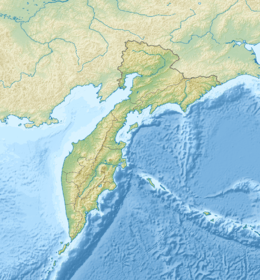Kell (volcano)
Kell (Russian: Келля) is a small extinct Holocene stratovolcano. It is located just north of the Zheltovsky volcano, within the Prizrak caldera on the southeast coast of the Kamchatka Peninsula in Russia.[1][2][3]
| Kell | |
|---|---|
 Kell Location in Kamchatka Krai, Russia | |
| Highest point | |
| Elevation | 900 m (3,000 ft) |
| Coordinates | 51.65°N 157.35°E |
| Geography | |
| Location | Kamchatka, Russia |
| Parent range | Eastern Range |
| Geology | |
| Mountain type | Stratovolcano |
| Last eruption | Unknown |
Because of its remote and inaccessible location, most information about the volcano comes from aerial surveys.[4] The volcano was discovered during an aerial survey in 1946.[3]
The Prizrak caldera has a diameter of about 4 km. It is located on top of the site of an ancient stratovolcano whose base has a diameter of about 10 km. The slopes of the caldera feature a network of erosional valleys.[3] Within the Prizrak caldera complex are at least three partially nested calderas, each about 3 to 5 km in diameter. Kell is the largest of several small stratovolcanoes, composed mainly of lava, in the innermost portion of the caldera. The caldera also contains lava domes.[1][2][4]
The innermost caldera is thought to date from the Late Pleistocene.[4] The activity of the volcano appears to have ceased in post-glacial time; there is no evidence of recent volcanism or hydrothermal activity.[2][3][4]
See also
References
- "Kell". Global Volcanism Program. Smithsonian Institution.
- Volcano World
- Sviatlovskii, A. E. (Aleksandr Evgenevich) (1959). Атлас Вулканов СССР [Atlas of Volcanoes of the Soviet Union]. Moscow: USSR Academy of Sciences. p. 85.
- Erlich, Edward (1986). Geology of Calderas of Kamchatka and Kurile Islands with Comparison to Calderas of Japan and the Aleutians (Report). U.S. Geological Survey. p. 100. Alaska Open-File Report 86-291.